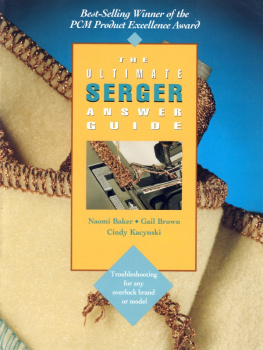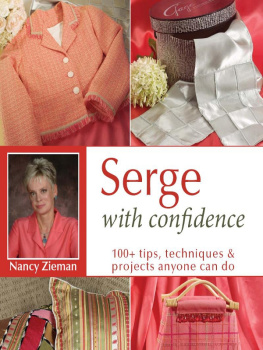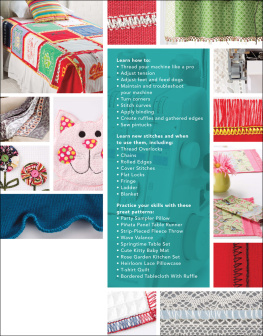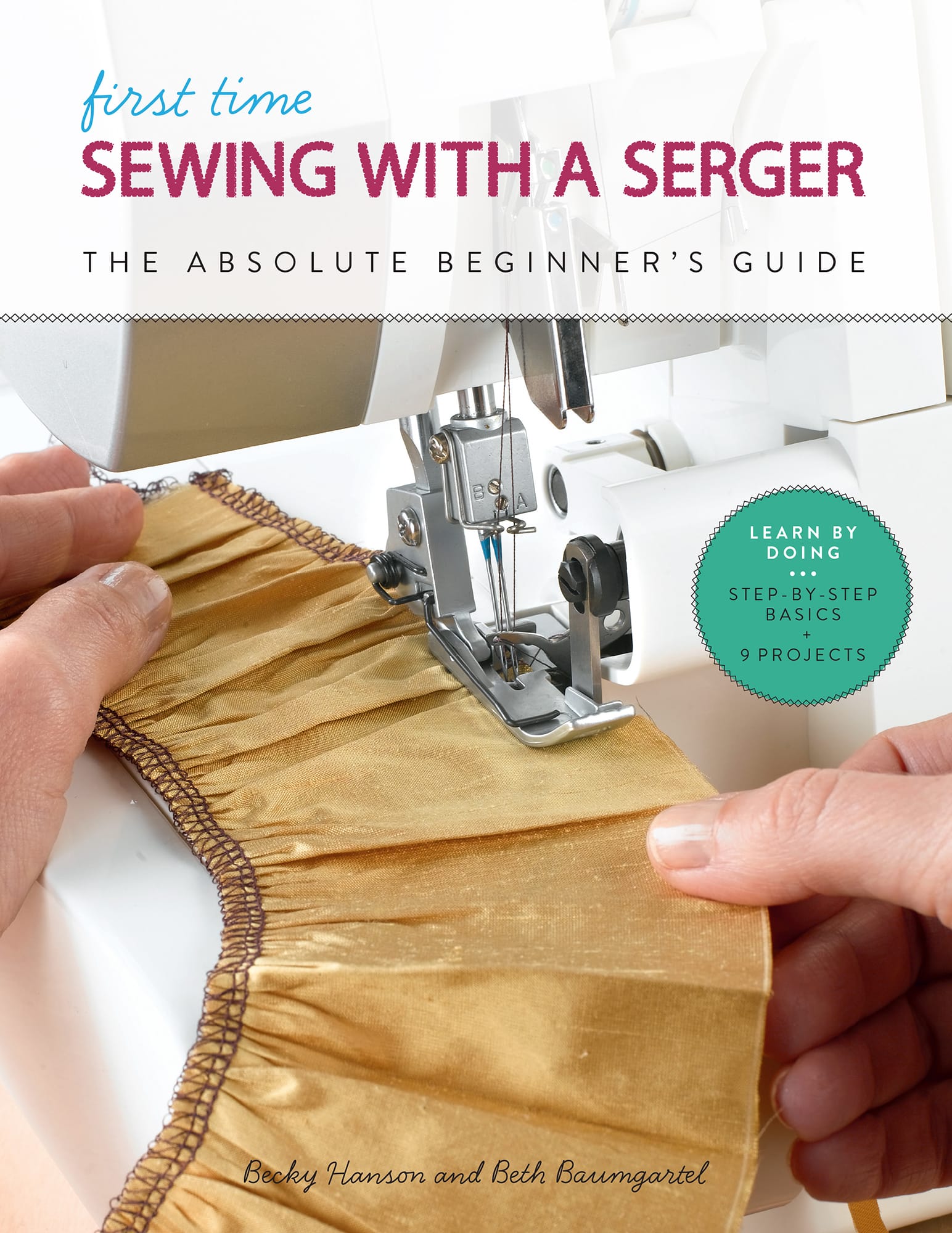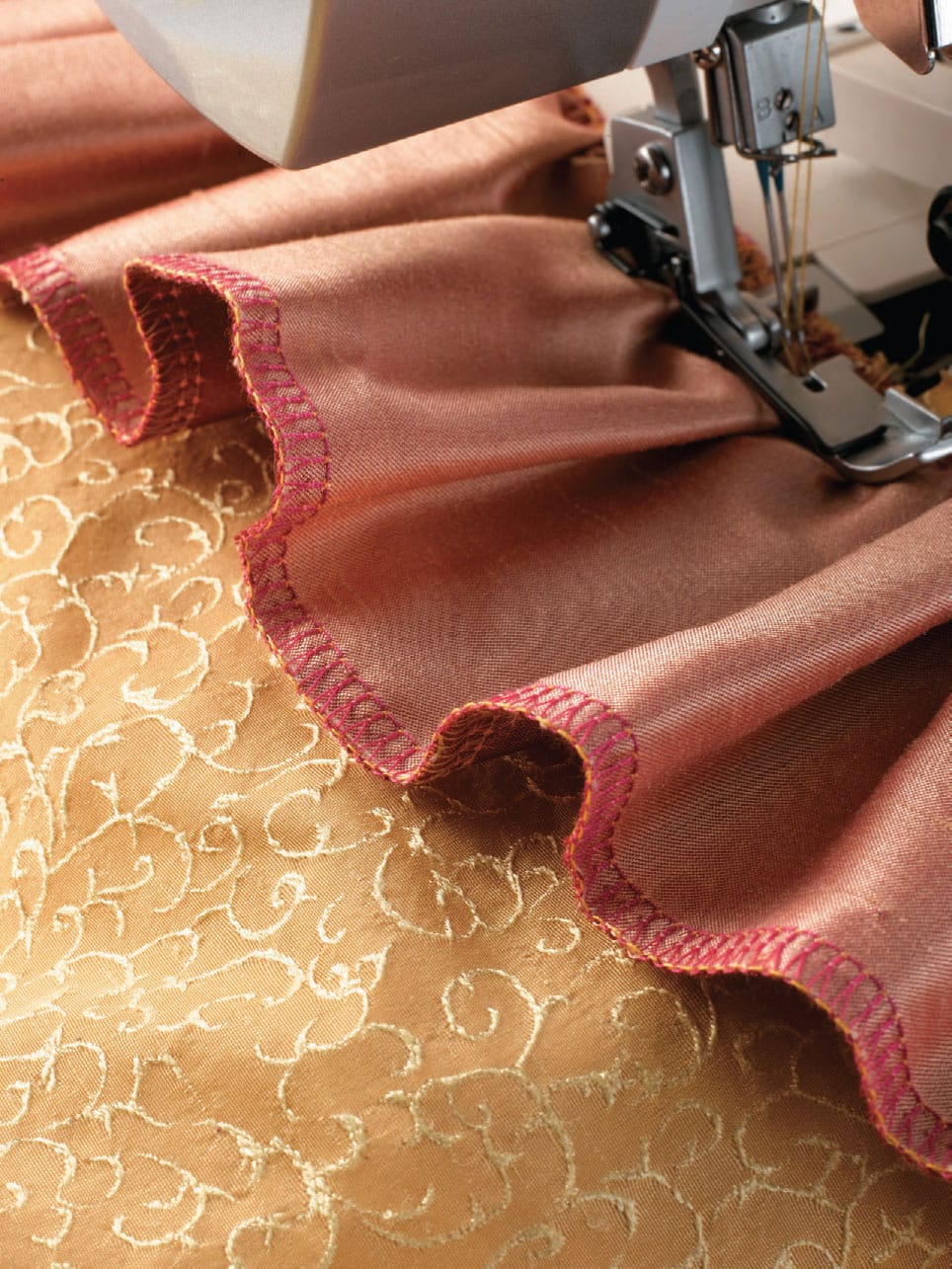Contents
Guide
first time
SEWING WITH A SERGER
THE ABSOLUTE BEGINNERS GUIDE
by Becky Hanson and Beth Baumgartel

Welcome to Serging
Have you ever wondered how store-bought garments or home dcor items get those perfectly stitched finished seams? Well, you can achieve this same professional finish on your own projectswith the help of a serger!
A serger, also known as an overlock machine, is different from a standard sewing machine. Although both machines sew stitches, they sew them differently. Each machine works best for different aspects of the sewing process. Just as a kitchen has a stove and a microwave oven, every sewing room should have a sewing machine and a serger. A serger helps make many of your sewing tasks faster and easier. It also allows you to create many specialty effects that arent possible with your sewing machine.
Once you start working with a serger, youll be amazed at how much time you save. Youll love the results, too. Soon, youll wonder how you ever got along without one!
Have fun! You can sew it!
ALL ABOUT SERGERS
If youve never sewn with a serger, youre in for a treat. Sergers are wonderful machines that trim the fabric edge, overcast it, and sew a seam all at the same time. They also sew lovely embellishment stitches and tightly rolled hems. Your serger will soon become one of the most useful tools in your sewing room. Its not difficult to useand youll soon appreciate how much more quickly you can sew and how professional looking your finished results will be!
What is a Serger?
A serger is also called an overlock or Merrow machine (the manufacturer of the industrial version). Overlock is really the name of the primary stitch formed by the machine, but the term is frequently used to describe the machine itself.
The serger stitches a seam while trimming and overcasting the seam allowance, all in one step. It is also perfect for edge finishing single layers of fabric for hemming or for a simple clean finished fabric edge. It moves at a speed of about 1,300 stitches per minutemuch faster than a standard home sewing machine. It can save hours of tedious seam finishing and give all your projects a more professional look, whether the serged stitches are functional (on the inside) or decorative (on the outside)!
A serger is typically defined by the number of threads it uses, anywhere from two to five (with additional threads if there are double or triple needles on a single shaft). The number of threads, in turn, determines how many stitches and what types of stitches the machine can form. (For a complete explanation of serger stitches, see shown .)
Sergers have been marketed to home sewers for only a few decades. The original machines were large, heavy, and loud, with exposed knives that were somewhat dangerous. Todays sergers are much more user-friendly and are available at many price points and with a range of features. Many models are computerized.
A serger cant entirely replace a sewing machine, but it can certainly enhance your overall sewing. You will find that the more you use your serger, the more comfortable and knowledgeable you will become, and the more youll be able to do with it. Whatever you call itthe serger, Merrow, or overlock machineonce you start using it, youll wonder what you ever did without it.

SERGER STITCH TYPES
To choose the best stitch for your projects, learn a little about each type of stitch. Each stitch style has its own look and its own function.
Two Threads
The overedge, flatlock, and rolled-edge stitches offer additional seaming and edge-finishing options. A two-thread chain stitch looks like a standard sewing straight stitch.
Three Threads
The three-thread overlock is used to seam and edge-finish knits and some lightweight woven fabrics. It is also the premier edge-finishing stitch.
Four Threads
A four-thread stitch is a little heavier and more secure than a three-thread stitch. The serger must have at least two needles to make most of these stitches.
Five Threads
With five threads, you get the most secure seam and edge-finishing stitch. The five-thread safety stitch combines the two-thread chain stitch with the three-thread overlock.
THE SERGER AND THE SEWING MACHINE
The serger is the perfect complement to your sewing machinefor its speed, its professional edge finishing, and its decorative versatility. Although it cant replace a sewing machine, you can sew entire projects on a serger, such as knit items and some home dcor projects.
The biggest difference between a sewing machine and a serger is that sergers have loopers instead of a bobbin for the lower thread. The thread passes through large eyes on the loopers, instead of wrapping around them, as it would around the bobbin. (See for a visual comparison.) You still need your sewing machine to sew facings, most zippers, buttonholes, topstitching, and tailoring. The sewing machine is essential when accuracy, precision, and garment fit are important.
You dont absolutely need a serger, of courseunless you sew professionallybut a serger certainly makes your sewing life easier, your finished projects more professional looking, and the sewing experience much more fun.
SEWING MACHINE AND SERGER FEATURES |
|---|
SEWING MACHINE | SERGER |
|---|
1 or 2 spools of thread, plus one bobbin | 2 to 10 spools of thread |
Lower thread feeds from a single bobbin | Lower thread feeds through loopers |
Threads penetrate fabric | Threads penetrate and/or wrap around fabric edge |
Machine can backstitch | Machine cannot backstitch |
Stitches precisely on curves and corners | Is challenging to stitch precisely on corners and curves |
Does not trim seam allowances | Trims seam allowances as it stitches |
How Sergers Stitch
How is a serger different from a standard sewing machine? One of the biggest differences is how the stitches are formed. A standard sewing machine has two threads: an upper thread, which goes through the needle, and a bobbin thread. When you sew, the threads meet within the fabric, locking together to form a stitch. A serger doesnt have a bobbin. Instead, it has loopers, which are curved, moving arms with an eye in one end. The looper carries thread fed from a spool through a series of guides. Your serger may have two or three loopers, depending on the type of serger it is.


